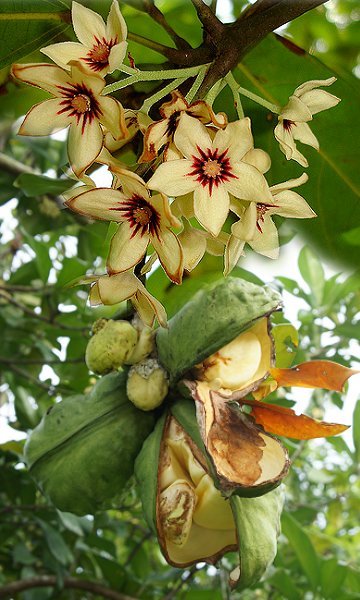
|
|
Kola nut (Cola nitida).
Flowera and fruits.
|
Kola nut - Cola nitida
Cola nitida is a species of plant belonging to the family
Malvaceae. It is a tree native to the rainforests of tropical West Africa, Sierra
Leone, Liberia, Ivory Coast, Ghana, and Nigeria, Common names include kola nut,
cola, kola and bitter kola. The seeds contain caffeine and are chewed as a stimulant and used in the manufacture of soft
drinks. The nuts and other parts of the tree have many uses of a ceremonial nature and in traditional
medicine. The timber has multiple uses.
Cola nitida is an evergreen tree growing to a height of 12 to 20 metres (39 to 66
ft). The trunk is up to 1.5 m (4 ft 11.1 in) in diameter and older trees develop
buttresses. The bark is thick and fibrous, with deep longitudinal fissures, but small branches are
smooth. It is grey or brownish-grey, with pinkish-red wood becoming visible when the bark is
damaged.
The leaves have stalks and are alternate,
oblong, glabrous, leathery dark green and tough, with untoothed wavy margins and up to 33
cm.
The flowers have parts in fives. They grow in panicles from the leaf axils and have no
petals. Male flowers have a deeply lobed, cup-shaped calyx about 2 cm (0.8 in) in diameter with two whorls of
stamens. Female flowers are larger at 5 cm (2.0 in) diameter, with five carpels. They are white with red marks
inside.
The calyx is yellow with red nectar guides, and are followed by fleshy fruits up to 13 cm (5.1
in) long and 7 cm (2.8 in) wide. The fruits are green, shiny, made up of 5 cells which curve
back, and contain about 10 seeds per fruit. When ripe, the pods split open to reveal the seeds which may be mottled
white, reddish-grey or brown. The seeds are bitter when fresh but become more aromatic as they
age.
Cola nitida is native to Sierra
Leone, Liberia, Ivory Coast, Ghana and Nigeria. It is a lowland tree but can be found up to altitudes of about 300 metres (980
ft) in areas with deep, rich soils and evenly distributed rainfall. It has been cultivated in other parts of tropical Africa as well as
India, Jamaica, Brazil, and Hawaii.
It can grow where there is around 1,200 millimetres (47 in) of rain but does better where the annual rainfall exceeds 1,700 millimetres (67
in), spread across eight months or more. Its temperature range is 23 to 28 °C (73 to 82 °F) and it grows on both light and heavy soils as long as they are
deep.
The nuts contain caffeine, theobromine and
tannin. Along with the closely related Cola acuminata, which is also native to West
Africa, the trees are cultivated commercially in tropical regions of the world and the nuts used in the manufacture of the popular soft drink called
cola. The cola drink consists of flavouring extracts of kola nut, spice oils, and other aromatics
and sometimes of coca (Erythroxylum coca) leaves; carmel colouring; sugar and other
sweeteners, singly or in combination; phosphoric acid or citric acid; carbon dioxide for
effervescence; and water (86 to 92 percent by volume). In diet cola drinks, artificial flavourings and sweeteners may
predominate, and the water content may near 100 percent.
In Africa the nut has traditionally been used as a stimulant when chewed. It is reported to lessen
fatigue, prevent hunger pangs, increase mental activity and reduce the need for
sleep. When chewed, it also has the effect of modifying the taste sensation so that any food or drink consumed immediately afterwards seems
sweet. Parts of the plant are also used in rituals such as weddings, child naming
ceremonies, induction of village chiefs, funerals and sacrificial ceremonies. The
leaves, twigs, bark, flowers and nuts are also used in traditional medicine. Cola nitida is closely related to Theobroma
cacao, the cocoa tree, and the nuts have been used as a main ingredient for chocolate with a high melting
point.
In medicine the refined extract is used as a cardiac and
central-nervous-system stimulant. The seeds are an astringent, bitter-sweet,
anti-depressant
herb that has a stimulant effect, especially on the heart[ 238 ]. The powdered
seeds are taken internally in tonics, in the treatment of exhaustion, low energy
and poor appetite. They are also used in treating diarrhoea.
The nut is used in dyeing and water purification. Furthermore, the plant is used as shade trees in cocoa
plantations. The wood is susceptible to borers but can be used. The timber has a use in building
work, boat construction, furniture and joinery, musical instruments, utensils and
carving. It is also useful as firewood. The pods have been used to make fertiliser and
soap, and they can be used as a substitute for up to 60% of the maize in poultry
feed.
Source:
https://en.wikipedia.org/wiki/Cola_nitida
https://www.britannica.com/plant/Cola-nitida
https://pfaf.org/user/Plant.aspx?LatinName=Cola+nitida
